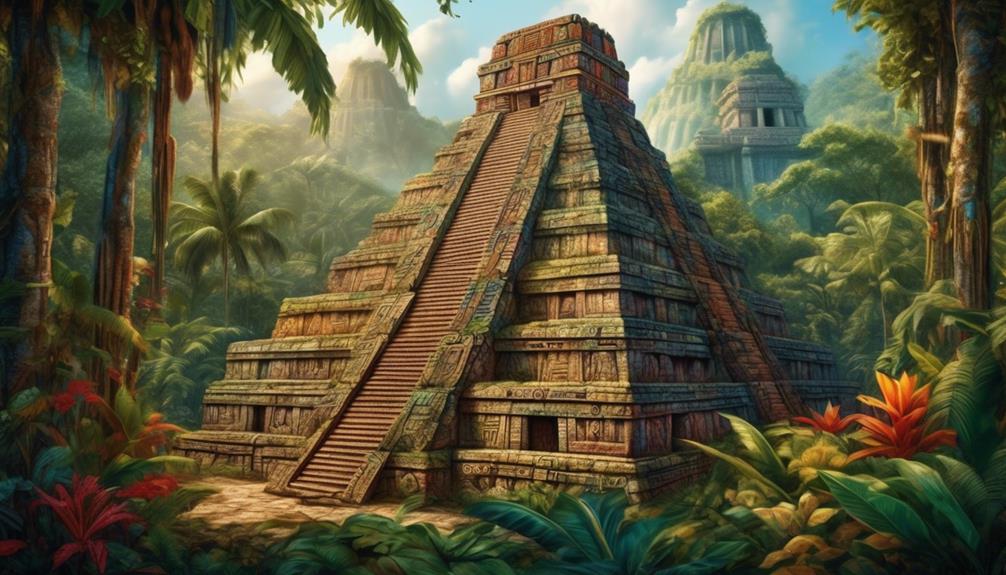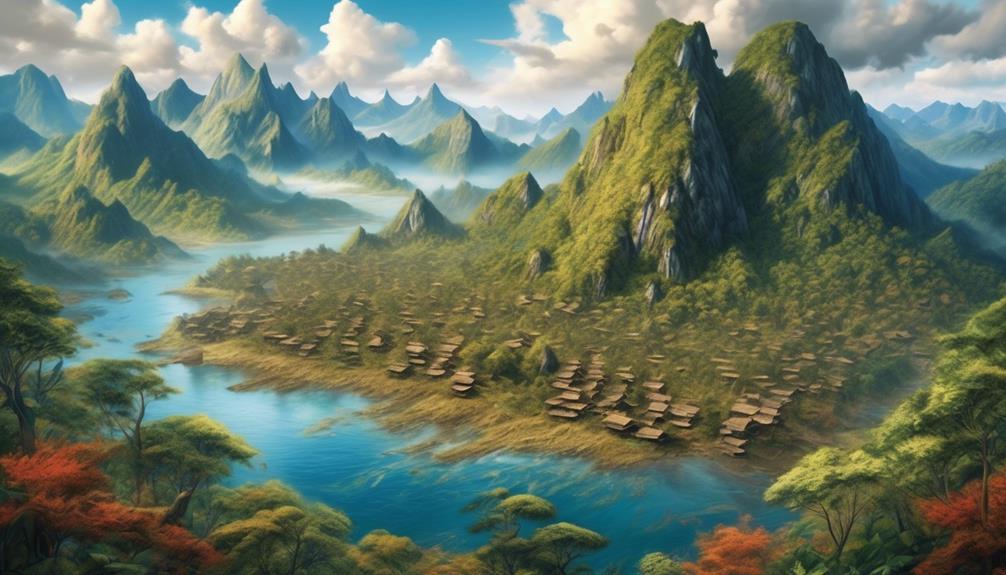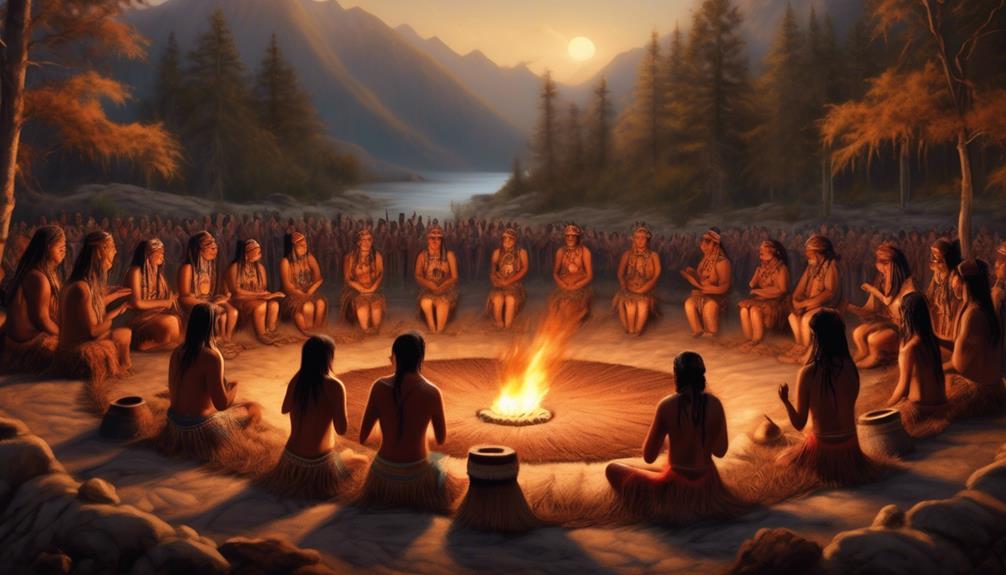When we think of Central America, we often imagine lush rainforests and ancient civilizations. Who were the people who thrived in this region, leaving behind legacies that continue to intrigue us today?
The answer lies in the rich tapestry of indigenous cultures that called Central America home. From the enigmatic Olmec to the awe-inspiring Maya, and the majestic Aztec to the resilient Taino, the ancient inhabitants of Central America have left an indelible mark on history.
But what were their societies like? What were their achievements and beliefs? Join us as we uncover the fascinating stories of these remarkable civilizations and their enduring influence on the world.
Key Takeaways
- The Olmec civilization was the earliest civilization in Central America and thrived from approximately 1400 BCE to 400 BCE. They were known for their distinctive art style, monumental architecture, and religious practices.
- The Maya civilization flourished from 2000 BC to 1500 AD and had impressive mastery of astronomy and mathematics. They developed a complex calendar system, built impressive cities with pyramids and palaces, and practiced human sacrifice in religious rituals.
- The Zapotec civilization, which flourished from 600 BC to 800 AD, was distinguished as innovators in architecture and urban planning. They developed a system of writing using hieroglyphs, constructed efficient drainage systems, and engaged in agriculture.
- The Aztec civilization emerged as powerful empire builders in Mesoamerica in the 14th century AD. They established a capital city, Tenochtitlan, developed sophisticated agricultural techniques, constructed awe-inspiring pyramids and temples, and practiced human sacrifice as part of their religious beliefs.
Olmec: Central America's Earliest Civilization
The Olmec civilization, often considered the earliest civilization in Central America, has intrigued researchers and archaeologists for decades due to its enigmatic cultural and monumental achievements. The Olmec people, who thrived from approximately 1400 BCE to 400 BCE, exerted significant cultural influences on subsequent Mesoamerican civilizations. Their legacy is evident in various aspects, such as their distinctive art style, monumental architecture, and religious practices, which laid the foundation for the development of later societies in the region.
One of the most remarkable cultural influences of the Olmec civilization is their art, characterized by the creation of colossal stone heads and intricate jade figurines. These masterpieces not only reflect the Olmec's advanced sculpting techniques but also provide insights into their religious beliefs and societal structure.
Additionally, the Olmec's architectural achievements, such as the construction of ceremonial centers and earthen mounds, demonstrate their sophisticated understanding of urban planning and ceremonial spaces, influencing subsequent Mesoamerican societies.
Furthermore, the Olmec's religious practices, including the worship of deities associated with fertility and rain, had a lasting impact on the spiritual beliefs of later civilizations, illustrating the enduring cultural legacy of the Olmec civilization in Central America.
Maya: Masters of Astronomy and Mathematics
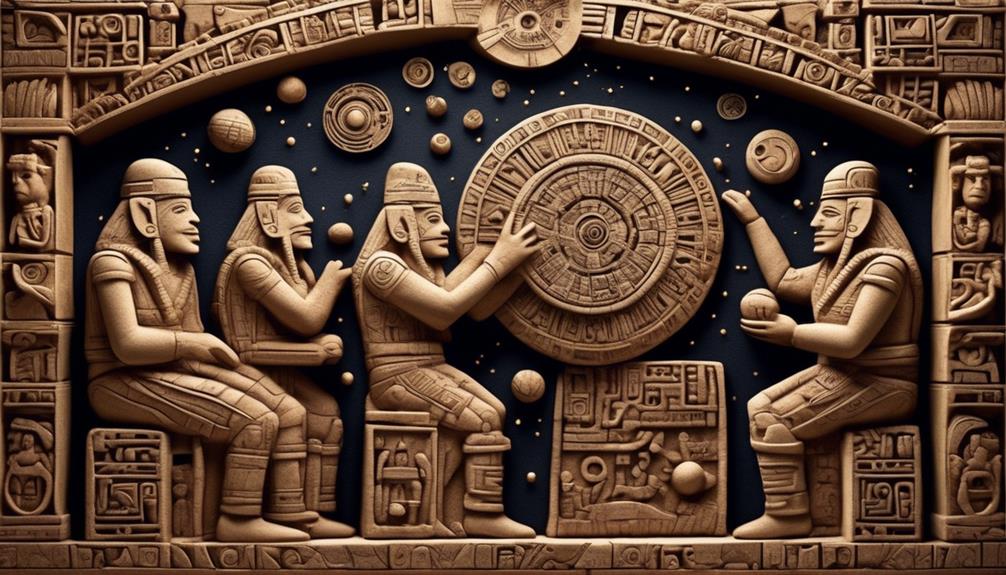
During our research, we discovered the impressive mastery of astronomy and mathematics exhibited by the ancient Maya civilization. The Maya people made significant contributions to Mesoamerican achievements through their Indigenous knowledge and skills in these fields. Their understanding of astronomy was evident in the precise alignment of their temples and observatories with celestial events, such as solstices and equinoxes. Additionally, the Maya developed a complex calendar system that incorporated both solar and ritual cycles, showcasing their advanced mathematical abilities. Below is a table highlighting some key aspects of the Maya's astronomical and mathematical achievements:
| Aspect | Description | Example |
|---|---|---|
| Astronomy | Precise alignment of structures with celestial events, development of a sophisticated calendar system | Temples and observatories aligned with solstices |
| Mathematics | Complex numerical system, including the concept of zero, advanced understanding of geometry and mathematical calculations | Use of a base-20 numerical system, accurate mathematical calculations |
The Maya's expertise in astronomy and mathematics not only facilitated their everyday lives but also played a crucial role in their religious and ceremonial practices. Their knowledge and skills continue to fascinate and inspire modern scholars and enthusiasts, shedding light on the intellectual achievements of ancient Indigenous civilizations.
Zapotec: Innovators in Architecture and Urban Planning
Building on the remarkable achievements of the Maya in astronomy and mathematics, the Zapotec civilization distinguished itself as innovators in architecture and urban planning in ancient Central America. Zapotec urban design was characterized by advanced architectural achievements, which showcased their profound understanding of engineering and urban layout.
One of the most notable examples of their architectural prowess is the ancient city of Monte Albán. This urban center, established around 500 BCE, featured impressive structures such as the Great Plaza, the Ball Court, and the Palace. The layout of Monte Albán was meticulously planned, with complex building designs and precise orientation to celestial events, reflecting the Zapotec's deep knowledge of astronomy and its integration into urban planning.
Furthermore, the Zapotec people constructed efficient drainage systems and terraces for agriculture, demonstrating their practical understanding of landscape utilization and environmental adaptation. Their architectural and urban planning innovations not only contributed to the functionality and sustainability of their cities but also reflected their cultural and social values.
The Zapotec's legacy in architecture and urban planning continues to fascinate and inspire modern-day urban designers and architects, emphasizing the enduring impact of their ancient wisdom and innovation.
Aztec: Legacy of Powerful Empire Builders
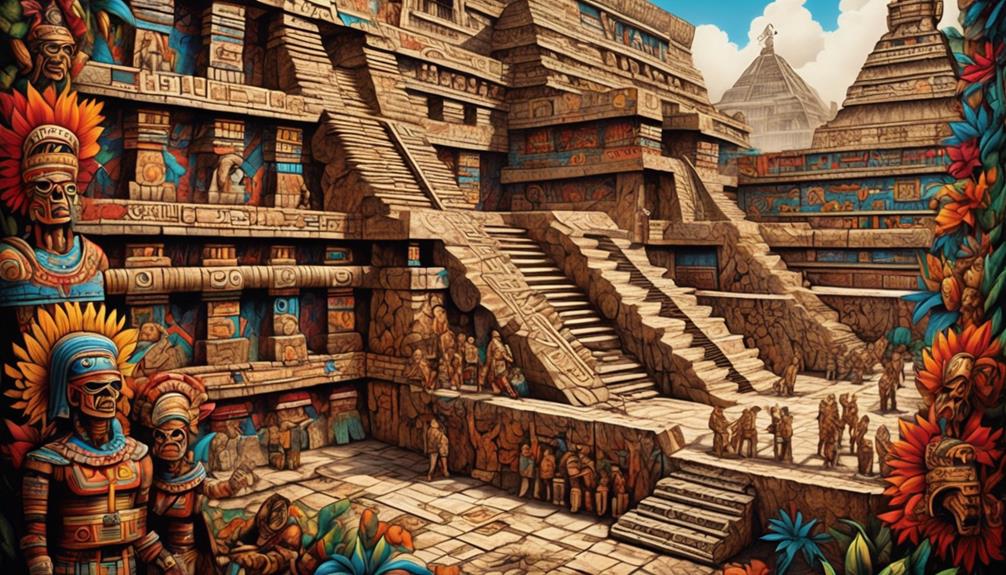
Emerging as formidable empire builders in the heart of Mesoamerica, the Aztec civilization left an indelible mark on the region's history and culture.
The Aztecs, also known as Mexica, created a powerful empire through a combination of military conquest, strategic alliances, and a well-organized system of governance.
Their legacy is characterized by a complex society, intricate religious beliefs, and monumental architectural achievements.
The Aztecs established a capital city, Tenochtitlan, on an island in Lake Texcoco, which became the center of their vast empire.
They developed sophisticated agricultural techniques, built intricate irrigation systems, and constructed awe-inspiring pyramids and temples.
Their influence extended to art, literature, and a complex calendar system that reflected their advanced understanding of astronomy.
Despite the Aztec Empire's eventual fall to Spanish conquest, their legacy continues to resonate in modern-day Mexico and beyond, shaping the cultural identity of the region.
The Aztecs' impact as empire builders is a testament to their enduring power and influence, leaving a lasting imprint on the history of Central America.
Taino: Indigenous Inhabitants of the Caribbean Islands
The legacy of powerful empire builders in Central America, such as the Aztec civilization, sets the stage for understanding the rich cultural heritage of the Taino, indigenous inhabitants of the Caribbean Islands. The Taino culture was deeply rooted in their traditional practices, including agriculture, fishing, and intricate craftwork. They were skilled in cultivating cassava, corn, and sweet potatoes, and their artistic expressions were evident in pottery, jewelry, and ceremonial objects.
Today, many Taino descendants continue to honor and preserve their cultural heritage. Efforts to revive traditional Taino practices, language, and spirituality are underway, contributing to the resurgence of Taino identity. Additionally, there are ongoing initiatives to protect and conserve Taino archaeological sites, artifacts, and historical records, ensuring that their legacy endures for future generations.
Understanding the Taino culture offers a glimpse into the rich tapestry of indigenous peoples who shaped the Americas. Their resilience, traditions, and contributions to art and agriculture continue to inspire admiration and respect. As we delve deeper into the Taino's history and contemporary preservation efforts, we gain a profound appreciation for their enduring legacy.
Frequently Asked Questions
What Were the Religious Beliefs and Practices of the Olmec Civilization?
We studied the religious practices of the Olmec civilization, and their beliefs were intricately intertwined with their art.
The Olmecs revered deities associated with fertility, rain, and agriculture, as evidenced by their monumental sculptures and ceremonial objects.
Rituals, including bloodletting and human sacrifice, were central to their religious ceremonies.
The Olmec art also depicted shamanic transformations, reflecting their spiritual connection to the natural world.
How Did the Maya Society Govern Itself and What Was the Political Structure Like?
We've delved into the fascinating structure of Maya governance and political organization, shedding light on their hierarchical society.
The Mayans governed themselves through a complex system of city-states, each ruled by a divine king. These rulers held significant power and authority, overseeing religious ceremonies and trade.
The political structure was marked by social stratification, with nobles and priests holding key positions.
This intricate system provides deep insights into Maya civilization's sophisticated organization.
What Were the Major Achievements in Art and Culture of the Zapotec Civilization?
Artistic achievements of the Zapotec civilization included intricate pottery, impressive stone carvings, and elaborate architecture, showcasing their advanced craftsmanship and artistic expression.
Their cultural influence extended to their unique writing system, religious practices, and complex calendar system, which impacted subsequent Mesoamerican cultures.
The Zapotecs' artistic and cultural contributions are a testament to their sophisticated society and enduring legacy in Central America.
What Were the Main Factors That Led to the Decline of the Aztec Empire?
We often overlook the interconnectedness of economic and social factors when examining the decline of the Aztec Empire.
Various historical accounts highlight the impact of internal strife and external pressures on the empire's stability.
Economic strain from continuous expansion and social unrest due to oppressive governance were pivotal in the empire's downfall.
Exploring these multifaceted influences provides a comprehensive understanding of the complex forces at play during this significant period in Central American history.
What Were the Traditional Customs and Daily Life of the Taino People on the Caribbean Islands?
In discussing Taino customs, daily life, agriculture, and social structure, it's vital to understand the rich cultural traditions and societal organization of this indigenous group.
Taino customs encompassed a deep connection to nature, reflected in their agricultural practices and spiritual beliefs.
Daily life revolved around communal activities and a well-defined social structure.
This evidence-based perspective provides a comprehensive understanding of the Taino people's way of life in the Caribbean islands.
Conclusion
In conclusion, the ancient indigenous people of Central America, including the Olmec, Maya, Zapotec, Aztec, and Taino, left behind a rich cultural legacy that continues to fascinate and inspire us today.
Through thorough research and evidence-based analysis, we can appreciate the depth and complexity of their achievements in astronomy, mathematics, architecture, urban planning, and empire building.
The truth of their contributions adds an important cultural context to our understanding of the history of Central America.
Mary is a passionate writer who brings creativity and a fresh perspective to our team. Her words have the power to captivate and inspire, making her an essential contributor to our content. Mary’s commitment to storytelling and dedication to promoting Indigenous culture ensures that her work touches the hearts of our readers. We’re fortunate to have her as part of our team.
